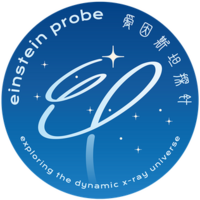
Back Einstein Probe German Einstein Probe French איינשטיין (גשושית) HE Einstein Probe Italian Einstein Probe Latvian/Lettish Einstein Probe Russian Einstein Probe Ukrainian 爱因斯坦探针卫星 Chinese
 Einstein Probe artist impression | |
| Names | Aiyinsitan Tanzhen |
|---|---|
| Mission type | Space observatory |
| Operator | CAS, ESA |
| COSPAR ID | 2024-007A |
| SATCAT no. | 58753 |
| Website | ep |
| Mission duration | 3 years (planned) 1 year and 3 days (ongoing) |
| Spacecraft properties | |
| Spacecraft | Einstein Probe |
| Bus | Phoenix-Eye-2 |
| Manufacturer | CAS |
| Launch mass | 1,450 kg (3,200 lb)[1] |
| Dimensions | 3 × 3.4 m (9.8 × 11.2 ft) |
| Start of mission | |
| Launch date | 9 January 2024, 07:02 UTC[2] |
| Rocket | Long March 2C[2] |
| Launch site | Xichang LC-3 |
| Contractor | CASC |
| Orbital parameters | |
| Reference system | Geocentric orbit |
| Regime | Low Earth orbit |
| Perigee altitude | 581 km |
| Apogee altitude | 596 km |
| Inclination | 29° |
| Period | 96 minutes |
| Instruments | |
| Wide-field X-ray Telescope (WXT) Follow-up X-ray Telescope (FXT) | |
 Einstein Probe Logo | |
The Einstein Probe (EP) is an X-ray space telescope mission by Chinese Academy of Sciences (CAS) in partnership with European Space Agency (ESA) and the Max Planck Institute for Extraterrestrial Physics (MPE) dedicated to time-domain high-energy astrophysics.[3][4] The primary goals are "to discover high-energy transients and monitor variable objects".[5] The telescope was launched by a Long March 2C rocket from the Xichang Satellite Launch Centre in China, on 9 January 2024, at 07:03 UTC.[6]
- ^ "Einstein Probe factsheet". ESA. Retrieved 10 January 2024.
- ^ a b Cite error: The named reference
esa-20240109was invoked but never defined (see the help page). - ^ "Einstein Probe in a nutshell". www.esa.int. Retrieved 28 December 2023.
- ^ "Einstein Probe factsheet". www.esa.int. Retrieved 28 December 2023.
- ^ "Einstein Probe Time Domain Astronomical Information Center". ep.bao.ac.cn. Retrieved 28 December 2023.
- ^ Jones, Andrew (January 9, 2024). "China launches "lobster eye" Einstein Probe to unveil mysteries of X-ray universe". spacenews.com.